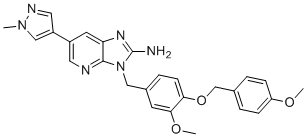
GZ389988
CAS No. 1788906-96-6
GZ389988 ( GZ-389988 | GZ 389988 )
产品货号. M12693 CAS No. 1788906-96-6
GZ389988 (GZ-389988) 是一种新型强效、选择性、局部递送的 TrkA 抑制剂,用于治疗骨关节炎;显示 TrkA、TrkB 和 TrkC 以及生长因子受体 cFMS (CSF1R) 的相似 IC50 值。
纯度: >98% (HPLC)
 COA
COA
 Datasheet
Datasheet
 HNMR
HNMR
 HPLC
HPLC
 MSDS
MSDS
 Handing Instructions
Handing Instructions
| 规格 | 价格/人民币 | 库存 | 数量 |
| 5MG | ¥7857 | 有现货 |


|
| 50MG | ¥16038 | 有现货 |


|
| 100MG | ¥20250 | 有现货 |


|
| 200MG | 获取报价 | 有现货 |


|
| 500MG | 获取报价 | 有现货 |


|
| 1G | 获取报价 | 有现货 |


|
生物学信息
-
产品名称GZ389988
-
注意事项本公司产品仅用于科研实验,不得用于人体或动物的临床与诊断
-
产品简述GZ389988 (GZ-389988) 是一种新型强效、选择性、局部递送的 TrkA 抑制剂,用于治疗骨关节炎;显示 TrkA、TrkB 和 TrkC 以及生长因子受体 cFMS (CSF1R) 的相似 IC50 值。
-
产品描述GZ389988 (GZ-389988) is a novel potent, selective, locally delivered TrkA inhibitor for the treatment osteoarthritis; shows similar IC50 values for TrkA, TrkB and TrkC, and the growth factor receptor cFMS (CSF1R), GZ389988 is highly selective against a wide panel of other kinases; GZ389988 can significantly reduces local joint pain, without effect on ipsilateral joint pain; GZ389988 also is efficacious in the PGPS arthritis model, demonstrating a significant improvement of gait analysis scores following painful disease reactivation flares.Other Indication Phase 2 Clinical.
-
体外实验——
-
体内实验——
-
同义词GZ-389988 | GZ 389988
-
通路Tyrosine Kinase
-
靶点Trk Receptor
-
受体Trk Receptor
-
研究领域Other Indications
-
适应症Other Disease
化学信息
-
CAS Number1788906-96-6
-
分子量470.533
-
分子式C26H26N6O3
-
纯度>98% (HPLC)
-
溶解度——
-
SMILESNC1=NC2=CC(C3=CN(C)N=C3)=CN=C2N1CC4=CC=C(OCC5=CC=C(OC)C=C5)C(OC)=C4
-
化学全称3-(3-methoxy-4-((4-methoxybenzyl)oxy)benzyl)-6-(1-methyl-1H-pyrazol-4-yl)-3H-imidazo[4,5-b]pyridin-2-amine
运输与储存
-
储存条件(-20℃)
-
运输条件With Ice Pack
-
稳定性≥ 2 years
参考文献
产品手册




关联产品
-
3-MATIDA
3-MATIDA 是一种有效的 mGluR-1 拮抗剂(IC50:6.3 μM,大鼠 mGluR-1a)。
-
LM11A-31
一种口服的脑渗透性 p75NTR 配体可以阻断 p75 介导的细胞死亡,还可以增加海马神经祖细胞的增殖和存活。
-
Cyclotraxin B
Antagonist of TrkB receptors; inhibits BDNF-induced TrkB activity (IC50 = 0.30 nM). Allosterically alters TrkB receptor conformation but does not alter BDNF binding. Prevents BDNF-induced cold allodynia in mice. Also shown to exhibit putative anxiolytic properties in mice.



 021-51111890
021-51111890 购物车(0)
购物车(0)
 sales@molnova.cn
sales@molnova.cn







